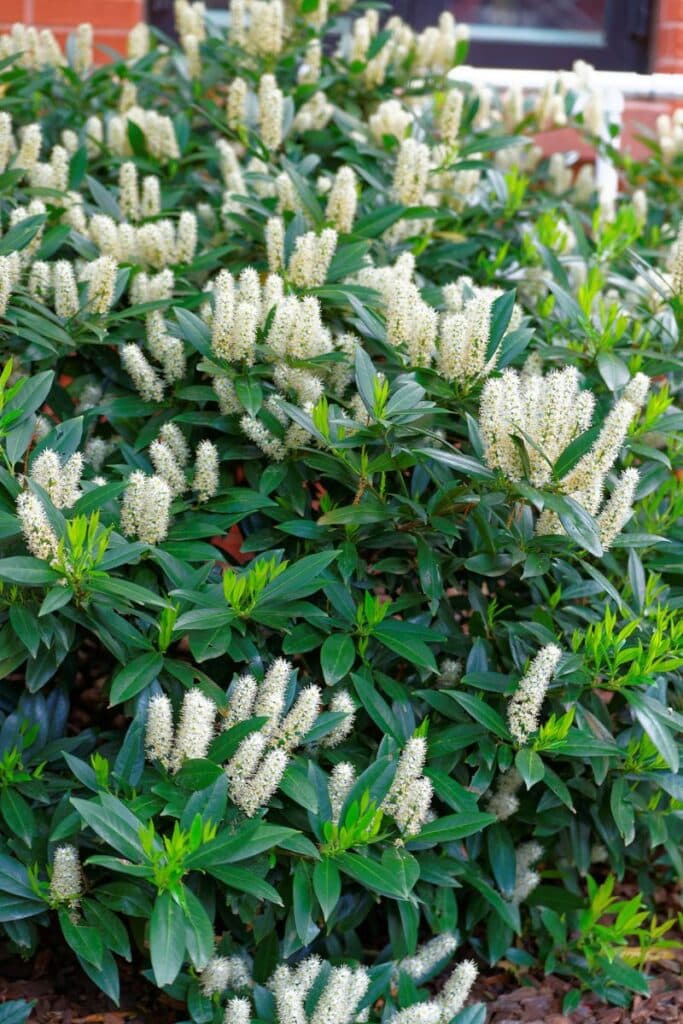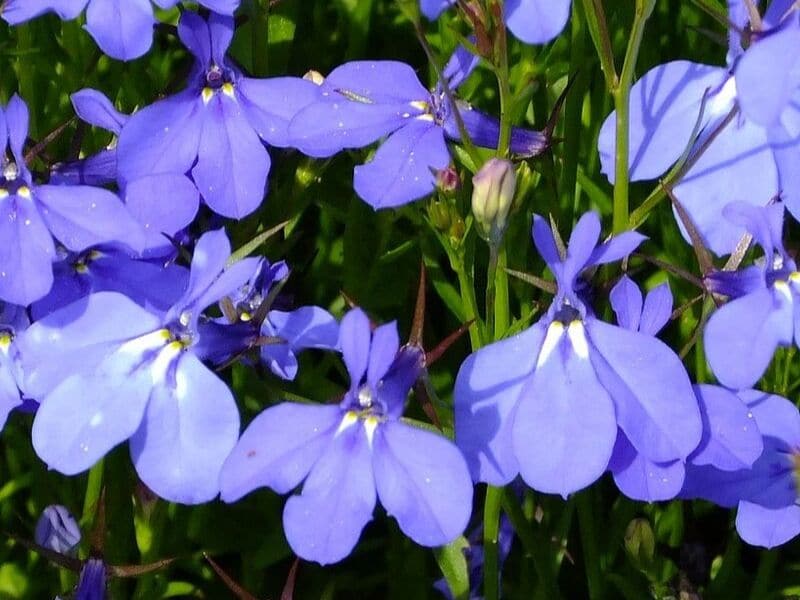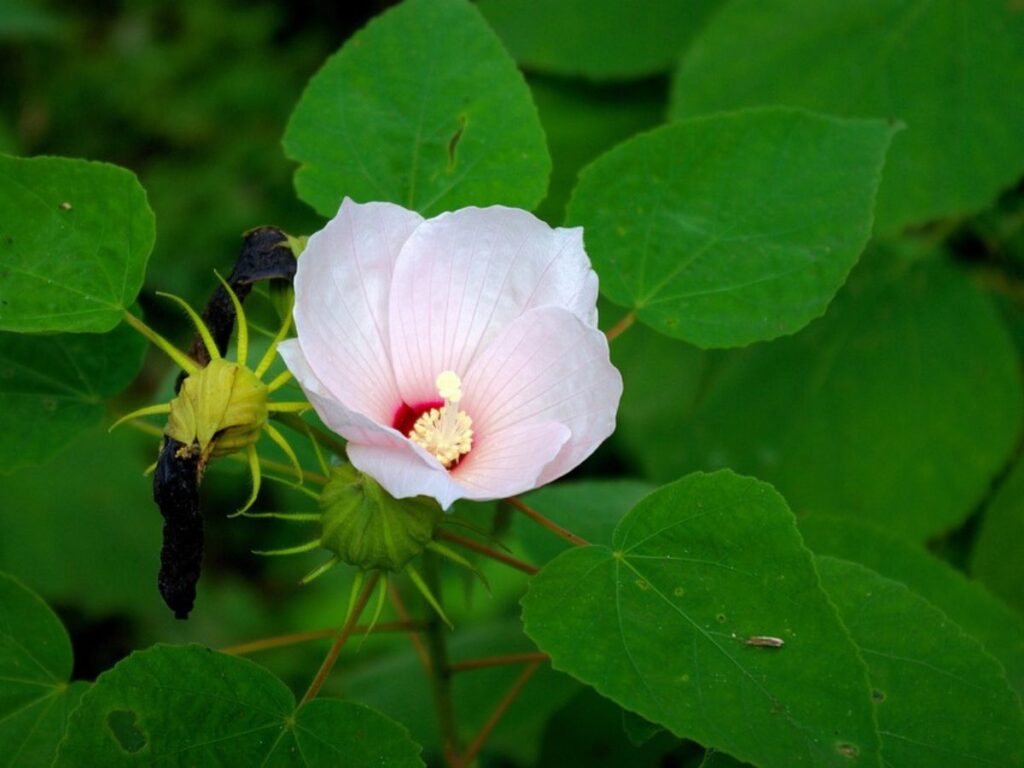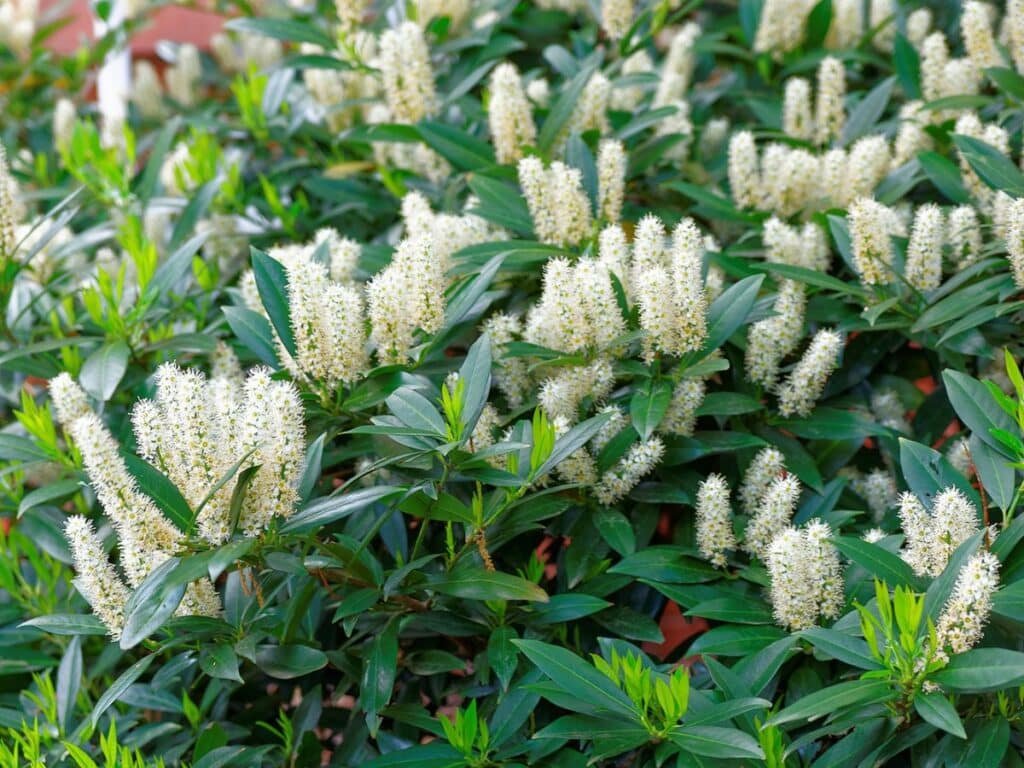Little Henry® Sweetspire (Itea virginica ‘Sprich’), also known as Virginia willow or Itea virginica Little Henry®, is a very charming shrub to add to your garden if you love sweet fragrant flowers. This plant will also add lots of multi-seasonal interest when its foliage transforms from deep green to vivid orange or red in Autumn.
If you want to get the most out of your Little Henry® then you should consider pairing it with companion plants like ferns, cardinal flowers, scarlet sage, bluestar flowers, and hibiscus trees.
These companions will enhance the beauty of your shrubs and some of them can be great for keeping your garden bed nice and full when the shrub shed’s its leaves for winter.
What to Grow with Little Henry Sweetspire

Gardeners love to pair their Little Henry shrubs with texture-rich companion plants. But one of the most important things to keep in mind when you are busy selecting companions is growing conditions.
It is very important to choose plants that have similar nutritional needs as Sweetspire Henry or some of the plants in your garden bed might not survive or grow well.
This perennial shrub is quite flexible since it can be planted in full sun to full shade. But one thing it is a bit particular about is watering. Henry sweetspire prefers moist soils and can tolerate wet conditions but it can wilt and die if it becomes too dry. Adult plants can survive dry conditions but they grow their best with regular watering.
Let’s take a look at some companion plants that can tolerate these moist conditions that Virginia sweetspire loves so much.
Christmas Fern
Christmas fern (Polystichum acrostichoides) is a great plant to pair with itea virginica Little Henry because it will add lots of texture to your garden, it is a great filler plant and the evergreen foliage will keep your garden vivid and lush even when your deciduous shrub shed’s its leaves for winter.
Christmas ferns are very easy to grow if you establish them in cool moist soil that drains well. These bushy plants can grow in full sun in cooler regions but, in general, they prefer part shade because hot sun rays can scorch their leaves.
These two plants have a similar height of about 3 feet tall. Because of their height, you can easily pair them in a garden bed to create mixed borders.
The mixture of color will look especially charming in autumn because the striking red foliage will form a strong contrast with the vivid green leaves of your ferns at this time of the year.
Cardinal Flower

Cardinal flowers (Lobelia cardinalis) can be a wonderful companion plant to select for your garden because it produces lots of upright spikes with masses of vivid flowers that can add lots of vertical interest to your garden.
The vivid red flower color will also create a strong contrast with your Little Henry®’s white flowers and is known to attract lots of native bees.
Cardinal plants can grow in full sun in colder climates but in warmer regions, they should be planted in partial shade. These flowers don’t need too much fertilizer but should be placed in humus-rich soil that is neutral to acidic. As with Little Henry®, they also prefer damp soil that drains well.
Cardinal flowers are taller than dwarf henrys which means you should grow them in the back of the garden so their tall spiky flowers can peek out from behind the dwarf sweetspire shrubs.
Blood Sage
Blood sage (Salvia Coccinea), also known as scarlet sage, can also look very attractive next to a Little Henry® bush because its vivid red flowers will create plenty of contrast in your garden while the salvia’s leaves will add more texture to your garden.
Sage will grow well if you place it in full sun. Gardeners should, however, be careful to place it in well-drained sandy soil because it doesn’t tolerate moisture too well and prefers dryer conditions.
These companion plants for Little Henry Sweetspire only grow 2 – 4 feet tall which means you can easily use them to create mixed borders or short mixed hedges.
Hubricht’s Bluestar
Hubricht’s bluestar flowers (Amsonia hubrichtii) can be good companions if you want to create a cool-toned garden and the delicate blue flowers will also add plenty of texture to your garden bed.
This flowering shrub also has evergreen leaves that can keep your garden lush and full during winter or conceal the bare branches of your shrubs when they are dormant.
Bluestar flowers can be grown in full sun or partial shade in well-drained soil. This plant loves moist soil and will flourish next to your sweetspire shrubs.
As with sweetspire, this perennial only grows up to 3 feet tall and can be grown right next to your other shrubs to create showy borders.
Rose Mallow

Rose mallow (Hibiscus moscheutos) is a terrific companion plant to consider if you want to create a backdrop for your Virginia sweetspire. These shrubs or small trees will produce lots of large showy white or pink flowers from mid to late summer.
Hibiscus shrubs can grow well in full sun or partial shade and they are perfect Little Henry itea companion plants because they love lots of moisture and can even survive in swamps and marshes.
Because rose mallow tends to be taller, it is usually best to grow them in the back of your garden with sweetspire shrubs in front to conceal the base of these small trees.
What NOT to Grow with Little Henry Sweetspire
Sweetspire Henry plants won’t grow well in dry conditions. They can tolerate a little bit of drought but are pretty moisture dependent. Because of their thirsty nature, it is usually best not to grow them with plants that cannot tolerate moisture.
You should avoid planting these shrubs with plants like coneflowers, lavender, dianthus, red valerian, or columbines because these types of plants will only develop root rot in the moist conditions that sweetspire henry plants require.
Landscaping ideas for Itea virginica Little Henry®
After discovering so many good companions for your garden, you are probably eager to get planting.
Here are a couple of creative ways to use this shrub and its companions in your garden for a terrific-looking landscape.
Mixed Borders or Natural Hedges
Mixed borders or hedges are very trendy in landscapes right now because they can add a lot of structure and charm to your garden. These showy borders can be used to edge off garden beds or to create a contrast next to roads or walkways.
You can pair henry sweetspire with other interesting texture-rich shrubs of a similar height like hubrich’s bluestar, blood sage, or cardinal flowers to create showy borders.
The flowering plants will keep your garden interesting from early summer while the sweetspire’s rich foliage colors will maintain the interest during the autumn season.
Conceal Unsightly Areas
Shrubs are very handy for covering up an unattractive area in your garden. You can use them to brighten up an unattractive wall or cover up an unattractive structure.
These shrubs will look charming as a backdrop with a shorter plant such as a Christmas fern in the front.
Multi-Seasonal Interest Gardens
It isn’t easy to create a garden that offers interest during all four seasons of the year. Most flowering plants will only bloom from early spring to early fall and can look rather dull for the rest of the season.
Some plants can also look charming during summer and fall but might look dull during winter when all the leaves have been shed.
By pairing different types of deciduous and evergreen plants like sweetspire and Christmas ferns together, you can keep your garden beds lush and full of color throughout the year.
Final Thoughts
Little Henry shrubs can look charming when you pair them with neighboring plants like Christmas ferns, cardinal flowers, blood sage, hubricht’s bluestar, or rose mallow and there are lots of clever landscape concepts that you can use to create a more beautiful garden.
We hope that this article guides you towards suitable plant species or a good landscape idea that can make your Virginia sweetspire stand out even more.
See more:
*image by erix2005/depositphotos







